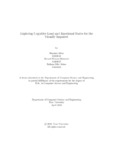Exploring cognitive load and emotional states for the visually impaired
Abstract
Cognitive load and emotional states may impact for designing an assistive navigation
aid for the Visually Impaired Peoples (VIPs). In this study, electroencephalogram
(EEG) signals were captured from participants with di erent degree sight loss peoples
(DDSLPs). EEG signals were then used to measure various cognitive loads
and emotions to test the usability of an intelligent navigation aids. To support the
argument of testing the usability of a navigation aids, the complexity of the tasks
in terms of cognitive load and emotions were quanti ed considering diverse factors
by extracting features from various well established entropies when DDSLPs will
navigate unfamiliar indoor environments with di erent obstacles. Experimental results
show that classi cation accuracy for narrow space is 97.61% for cognitive load.
Moreover, the experiment achieves that 90.40% and 50.60% classi cation accuracy
for arousal and valence in the open space and stairs, respectively.

